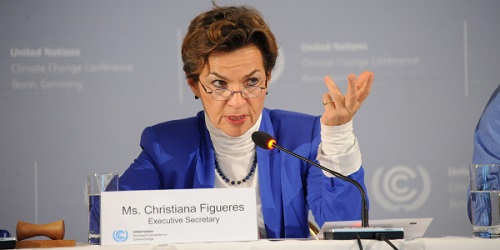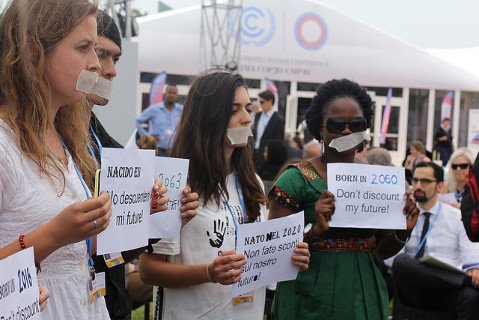The UNFCCC Conference of Parties (now 194 countries, I think) has reached the midway point. I’ve compiled some news coming out of the conference in the style of Climate clippings.
Here’s the UNFCCC executive secretary Christiana Figueres in action:

1. The first five days of the Lima climate change conference
Mat Hope sums up at The Carbon Brief.
-
1) The need to get a deal is being talked up
There is an upbeat feel as the Paris conference next December looms, where a deal is scheduled to be cut.
-
2) Expectations are being managed
They hope to complete a draft text at Lima, but it is only a stepping stone.
3) The US-China climate deal means the spotlight is on India
With the US, China and the EU making positive pledges, eyes now turn to India. So far they have been true to form, grumbling that the developed countries should do more and provide finance for adaptation.
-
4) Record temperatures and typhoon threat are framing the conference
In Copenhagen in 2009 it was freezing. At Lima the atmospherics a quite different with looming record world temperatures and typhoon Hagupit making its way towards the Philippines.
-
5) Old divisions persist
The EU wants countries’ pledges to cut emissions to be legally binding. The US is adamant that this can’t be the case as it would then have to ask Congress to ratify the deal.
A group comprising Saudi Arabia, China, India and 30 other ‘like minded nations’ continues to call for more transparency in the process. The group has used such pleas as a delaying and blocking tactic at previous negotiations.
2. Australia drags the chain at Lima
Australia has distanced itself from the Cartagena Dialogue, a group of 30 or so “progressive” countries Australia helped found five years ago seeking an “ambitious, comprehensive, and legally binding regime in the UNFCCC, and committed, domestically, to becoming or remaining low carbon economies.” You’re right, that’s not Australia now.
Giles Parkinson thinks that Australia’s main aim is to keep selling coal. That’s why Andrew Robb is there as Minister for Trade.
Effectively and, from Robb’s tweets and other evidence, in fact Australia is channelling the thoughts of their favourite thinker, Bjorn Lomborg:
who as others have pointed out has made quite a nice career casting doubt on the seriousness of climate change, arguing the problem is overstated, and concluding that on a cost-benefit analysis there is no need to do anything. That pretty much sums up current Coalition government policy.
3. China fingers Australia
One point of permanent discontent has been that developing countries would like more effort to be put into the Green Climate Fund designed to help them to adapt and mitigate climate change. China has called the $9.7 billion contributed so far by 22 countries as “far from adequate”.
In doing so China has fingered Australia as a climate bludger. Australia’s policy is to contribute nothing. So far the GFC
has received funding pledges of $3 billion from the United States, $1.5 billion from Japan, $1 billion from the UK and France, $900m from Germany as well as pledges of at least $100m from Sweden, Italy, Norway, Holland, South Korea, Switzerland and Finland. It has even received a small contribution from New Zealand.
Even Canada has stumped up $300 million.
The original pledge at Copenhagen in 2009 had been $100 billion per year by 2020 from public and private sources.
One thing they are discussing is the form of each country’s pledge of climate action to be submitted in draft by march 2015. The only way they will agree on anything is to use the principle of ‘common but differentiated responsibilities’ adopted in Copenhagen. This leaves countries to make it up as they wish, which means different base and target dates.
This makes comparisons difficult.
They also have yet to decide whether the basic division of Annexe 1 used in the Kyoto agreement will be retained. With Kyoto only the developed Annexe 1 countries made pledges. The US wants to eliminate subcategories. Brazil has proposed three concentric circles:
In the innermost circle, developed and Annex I Parties would commit to absolute, economy-wide mitigation targets. In the next ring, developing countries would commit to economy-wide targets that are relative to national gross domestic product, business-as-usual emissions trends or population size. In the outermost ring, the least-developed countries would commit to objectives on reducing emissions that are not economy-wide.
I’m betting on one undifferentiated blob, because they won’t all agree on anything else.
Similarly on whether pledges should be legally binding, they’ll never agree, because the US will point blank never agree to it, and all countries must agree for a decision to stand. Perhaps the New Zealand option of making reporting legally binding, but not the content of the contributions themselves, will get up.
5. Ban Ki-moon singles out Canada
Meanwhile UN Secretary General Ban Ki-moon has told Canada to get its finger out and start setting goals. Leadership is expected of G7 countries.
6. The bottom line
Emily Williams writing in the Santa Barbera Independent points to the sad truth – the proposals coming forward, the US-China announcement notwithstanding, “would mean ‘game over’ for the planet and the most vulnerable communities.”
The pressure is for an agreement, any agreement, to avoid “Nopenhagen” in Paris. Her article carries this image of young protestors in Lima:

Perhaps this image would be more appropriate:


